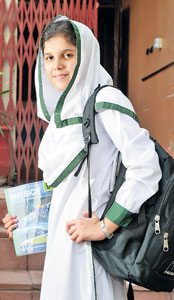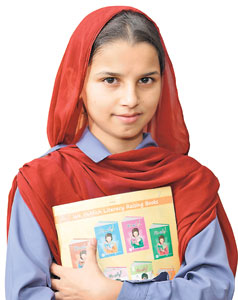International Day of the Girl Child is observed on October, 11, all around the globe to increase awareness about gender equality and provide more opportunities for the girl child. This week You! takes a look at an initiative in Rawalpindi that aims to empower young girls...
International Day of the Girl Child is observed on October, 11, all around the globe to increase awareness about gender equality and provide more opportunities for the girl child. This week You! takes a look at an initiative in Rawalpindi that aims to empower young girls...
The world has 1.1 billion girls today who are brimming with talent and creativity. Yet, it is rather unfortunate that their dreams and potential are limited due to the lack of opportunities and not to forget discrimination. There are glaring gaps between the opportunities they receive as compared to boys of their age. In an attempt to bridge this gap, the United Nations declared 11th October as the International Day of Girl Child in 2012. Since then, this day is celebrated globally to provide more opportunities for young girls and to increase awareness about gender equality. This effort aims to provide girls the right and access to education, nutrition, medical care, legal rights, protection from various kinds of discrimination and violence and elimination of child marriage.
Unfortunately, most of these issues and limitations are more prevalent in Pakistan and other developing countries as compared to the rest of the world. With reference to the child marriage issue, last year, a UNICEF report revealed that 3 per cent of the female population of Pakistan gets married before the age of 15 and 21 per cent gets married by the age of 18. These figures point towards how serious the issue of child marriage is in Pakistan. Sadly, there is still a long way to go before girls get protection from discrimination and have implementable legal rights.
In a scenario like this, any effort or initiative that aims to empower specifically the girl child and women, needs to be lauded and encouraged. ‘The Saba Homes’ in Rawalpindi is one such effort that aims to empower the girl child, especially those girls who have lost their parents. It is a safe haven for over 40 young girls who are getting education under the supervision of Saghir Aslam and his wife Bushra who they fondly call mama and papa. According to Aslam, “The 2005 earthquake left hundreds of children orphaned and homeless. After this devastating disaster, I met so many children and I thought ‘they don’t have to be treated like orphans just because their parents have passed away’ and that is when the idea of Saba Homes became a reality in 2006.”
From a dream to a reality
The initiative of Saba Homes, although noble, required immense effort, funds and determination. Aslam and his wife poured their savings and used their own residence to provide space to girls who had lost their parents. They donated the house to the trust eventually and as the house started filling up with young girls of varying ages, word got out and they started receiving donations to keep things going.
Just when Aslam and his wife realised they need to expand, a grant from USAID’s Small Grants and Ambassador’s Fund Programme (SGAFP) helped them reach their expansion goals. The Small grants programme aims to engage with civil society and communities to increase safe access to quality education for girls.
Since 2010, SGAFP has awarded 335 diverse and innovative projects worth of US $36 million throughout the country benefiting more than two million people - 55 per cent of whom are females. The project has recently provided grant to the Saba Aslam Education and Welfare Trust - known as the ‘Saba Homes School and Orphanage’ to build a three-storey school in Rawalpindi. The school provides access to education to vulnerable and marginalized girls. Saba Homes now has a trust, which is managed by independent board of directors.
What the girls have to say...
“I am brave and I can achieve what others can’t. I will be a trendsetter and people will follow me. I will serve humanity and spend my energy and strength for my cause. I can do everything with the support of my mama and papa,” repeat 40 young girls every morning to instil self-confidence and faith in them.
This activity is done repeatedly every day to remind these girls that they are the leaders. It also encourages them to broaden their horizon, dare to dream big and run after their aspirations and dreams. The girls living there are aspiring to become doctors, engineers, teachers, artists and leaders with the hope to give back to the society.
 Summaiya Akhtar, a student of ninth grade, aspires to become a doctor. “I have been at the Saba Homes for almost a decade. This place has not just been a home but it has also helped me to become independent, work hard, develop moral ethics and give back to the society. Mama and papa have loved me like real parents and I hope to make them very proud one day,” she says.
Summaiya Akhtar, a student of ninth grade, aspires to become a doctor. “I have been at the Saba Homes for almost a decade. This place has not just been a home but it has also helped me to become independent, work hard, develop moral ethics and give back to the society. Mama and papa have loved me like real parents and I hope to make them very proud one day,” she says.
Another girl, Madiha Yasmeen who just turned 11 and is studying in fifth grade is passionate about arts and wants to become an artist one day. “This is my sixth year at Saba Homes and I have become very confident. Living with so many girls of my age has taught me that girls have the talent to achieve whatever their hearts desire,” shares Madiha.
Summaiya and Madiha are just two of the many girls who have developed a vision and purpose of life despite losing their real parents. Most of these girls realize that they have been given a golden opportunity and feel it is their responsibility to ensure they can give this opportunity to someone else when they grow up. Such is the legacy of this effort.
Shed the stigma
In a society where the girl child is considered an unbearable responsibility and even the most educated and financially stable people feel upset on the birth of a girl child, initiatives like the Saba Homes are a ray of hope. They are a reminder that the girl child is a blessing and deserves the same love, respect and opportunities that children of the other gender receive. It’s about time we shed the stigma associated with girl child.
For a real shift in the society’s perspective towards the girl child, we need to take individual steps at home too. We need to empower the girl child from day one to ensure it never seems like a burden on the society. From little steps like letting them make their own choices and encouraging them to choose a car instead of a doll when they want a toy or appreciating them when they pick a colour other than pink. Our daughters need empowerment and conversations about what it means to be a woman in today’s world and how their capabilities and talents can help them touch the sky. We need to start raising our daughters differently but we also need to start raising our sons differently in order to achieve a world where the girl child is just as desired as a boy child.
Photography by author